You can identify diffusion treatments in sapphires by examining color concentration patterns—diffusion-treated stones show vibrant color in the center that fades toward edges, while heat-treated sapphires display angular zoning with uniform distribution. Look for crackled textures and feather-like inclusions in diffusion-treated stones, and use immersion testing in water or methylene iodide to enhance visibility of color zones. These visual techniques provide 80% accuracy in distinguishing treatments, though advanced laboratory analysis reveals the complete picture.
Understanding Diffusion Treatments Vs Heat Treatment
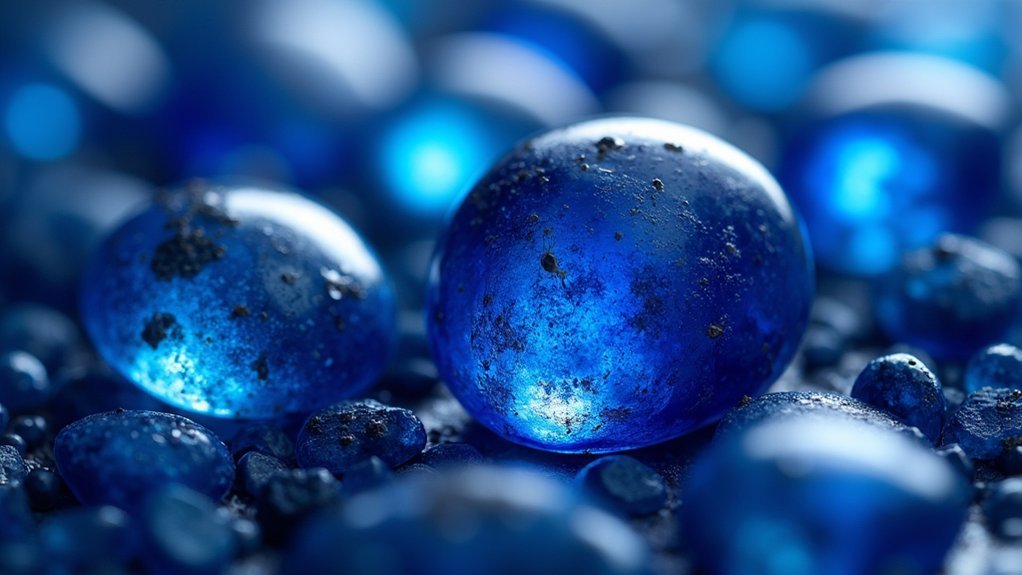
When you’re evaluating sapphires, you’ll encounter two distinctly different enhancement processes that dramatically affect both appearance and value.
Heat treatment represents the standard sapphire enhancement method, used on approximately 95% of stones to improve existing colors and clarity without introducing foreign elements. This process simply optimizes what nature already created.
Heat treatment enhances nature’s work in 95% of sapphires, improving color and clarity without adding foreign elements.
Diffusion treatments, however, involve introducing color-inducing elements like titanium and beryllium into sapphires at high temperatures.
Unlike heat treatment that enhances natural characteristics, diffusion treatments fundamentally alter the stone’s composition by adding new chemical elements. This creates vibrant colors that wouldn’t naturally exist in the original stone.
You’ll find that while heat-treated sapphires maintain significant value at around $1,500 per carat, diffusion-treated stones typically sell for only $15 per carat due to their artificial enhancement.
Visual Indicators of Treated Sapphires
Identifying these treatment differences requires careful visual examination of the sapphire’s physical characteristics.
When you’re examining stones for diffusion treatment, look for distinctive color zoning patterns that appear uniform in the center with angular concentrations around edges. You’ll notice diffusion-treated sapphires often display more vibrant hues that enhance visual appeal, though these colors tend to be less stable than natural ones.
Check for textural differences too.
Diffusion treatments typically create crackled textures and feather-like inclusions, while heat-treated stones show melted inclusions and needle-like formations. You’ll also observe that diffusion-treated sapphires may lack natural inclusions, resulting in smoother appearances.
Use immersion techniques in water or methylene iodide to better reveal these telling color zones and treatment indicators.
Color Concentration Patterns in Diffusion-Treated Stones
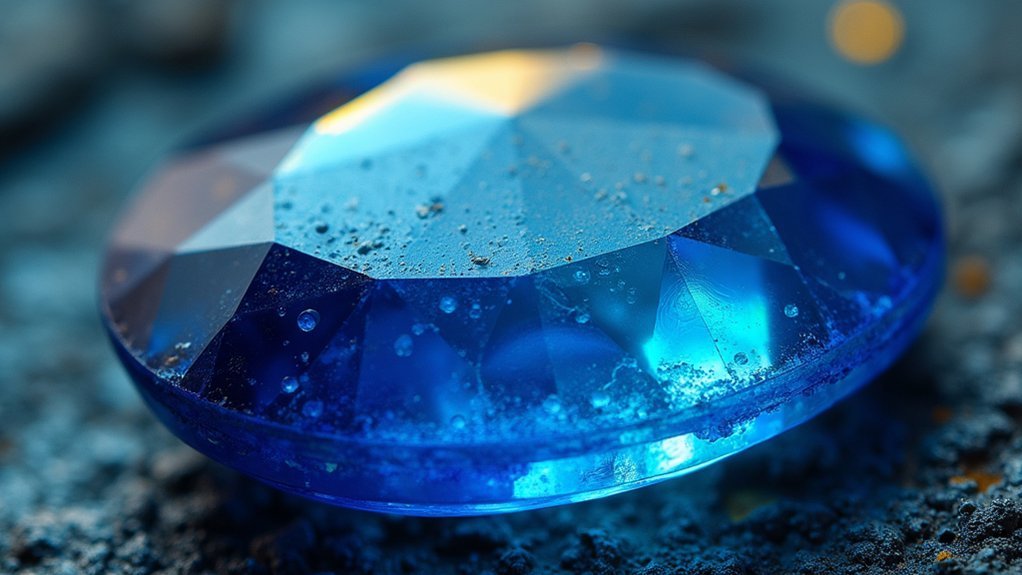
When you’re examining a diffusion-treated sapphire, you’ll notice the most vibrant color concentrates in the stone’s center while fading to lighter shades at the edges.
This sharp shift contrasts with heat-treated sapphires, which show angular zoning patterns and more uniform color distribution throughout.
You can achieve about 80% accuracy in identifying diffusion treatments by carefully observing these distinct color concentration and zoning characteristics.
Central Color Concentration Signs
One of the most revealing indicators of diffusion treatment appears in the distinctive color concentration patterns that develop within treated sapphires.
Unlike normally heat-treated sapphires that display uniform color distribution, diffusion-treated stones exhibit central color concentration that diminishes toward the edges. You’ll notice the color intensity peaks at the stone’s center, creating a telltale signature of this enhancement process.
When examining suspected stones, look for these key indicators:
- Angular zoning patterns suggesting uneven color penetration
- Distinct “halo” effects around inclusions with vibrant color cores
- Feather inclusions accompanied by crackled textures
- Intense saturation concentrated primarily in outer layers
Visual examination correctly identifies diffusion treatment approximately 80% of the time through careful comparison with untreated stones.
Angular Zoning Differences
Angular zoning patterns provide the most definitive visual evidence for distinguishing diffusion-treated sapphires from their heat-treated counterparts.
You’ll notice that diffusion-treated stones display sharp, well-defined color bands that appear at distinct angles throughout the gem. These angular zoning features create dramatic contrasts between light and dark areas, unlike the gradual color changes you’d see in heat-treated sapphires.
When examining color zoning patterns, you can achieve 80% confidence in identifying diffusion treatments by looking for these pronounced angular boundaries.
The intensity and definition of these zones greatly exceed what you’d observe in normal heat-treated sapphires. For clearer visualization, immerse the stone in methanol iodide during examination.
This technique enhances the visibility of internal structures, making the characteristic angular zoning differences more apparent and helping you definitively distinguish between treatment methods.
Angular Zoning in Natural Heat-Treated Sapphires
You’ll notice angular zoning patterns as one of the most reliable indicators when identifying natural heat-treated sapphires versus their diffusion-treated counterparts.
These distinctive color bands radiate outward from the stone’s center, creating geometric patterns that stem from the geological formation process rather than laboratory treatments.
When you examine sapphires under diffused white lighting, these angular zones can give you up to 80% confidence in distinguishing natural heat-treated stones from diffusion-treated specimens.
Angular Zoning Patterns
When examining natural heat-treated sapphires under magnification, you’ll notice distinctive angular zoning patterns that appear as sharp, straight lines delineating different color concentrations within the stone.
These patterns develop during natural crystal formation and remain visible even after heating processes. Unlike diffusion-treated stones that show consistent color distribution, untreated sapphires retain these geometric boundaries that create less uniform color arrangements.
Angular zoning patterns serve as reliable indicators when identifying treatment methods:
- Sharp, straight-line boundaries between color zones
- Geometric arrangements following crystal structure
- Inconsistent color distribution throughout the stone
- Clear contrast with diffuse coloring of treated specimens
You’ll achieve 80% confidence in identifying natural heat-treated stones by recognizing these patterns.
Microscopic examination reveals these critical features that help determine treatment history and establish proper valuation.
Heat Treatment Indicators
Since heat treatment alters a sapphire’s internal structure in predictable ways, identifying these modifications becomes essential for accurate gemstone evaluation. You’ll notice distinct angular zoning patterns that serve as reliable heat treatment indicators. These sharp-edged color bands contrast dramatically with diffusion-treated stones’ uniform appearance.
| Heat Treatment Indicators | Natural Heat-Treated | Diffusion-Treated |
|---|---|---|
| Color Distribution | Angular zoning patterns | Uniform color bands |
| Edge Characteristics | Sharp, distinct boundaries | Gradual shifts |
| Internal Structure | Preserved natural inclusions | Modified surface layers |
| Identification Confidence | 80% visual accuracy | Requires advanced testing |
You can enhance visibility of angular zoning through immersion techniques using methanol iodide or water. The controlled heating process preserves natural inclusions while creating these diagnostic patterns, making visual inspection your primary tool for gemstone evaluation.
Immersion Testing Techniques for Detection
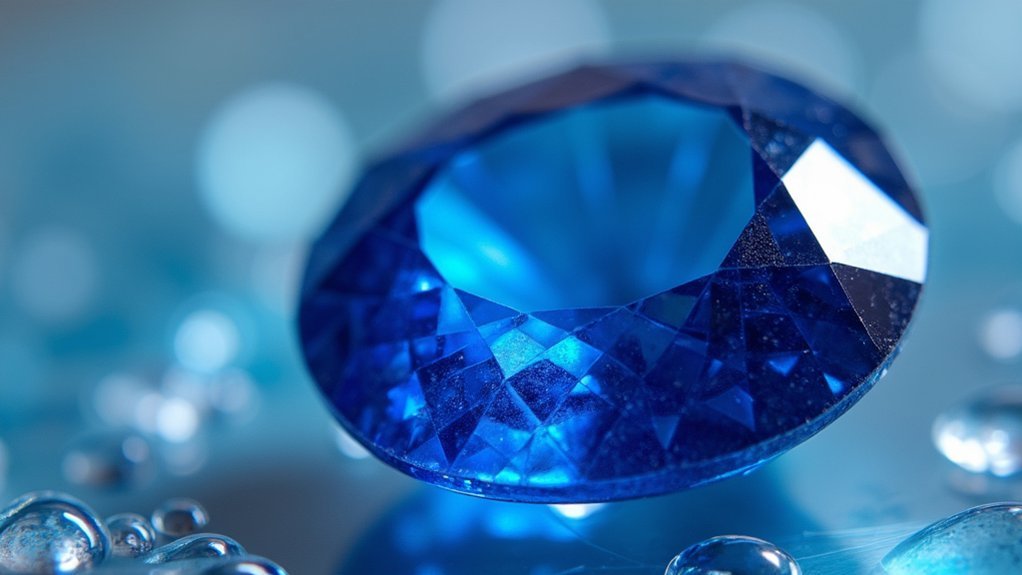
Immersion testing offers a straightforward yet effective method for detecting diffusion treatments in sapphires through visual examination of internal color patterns.
You’ll submerge the stone in a liquid medium to observe color zoning and concentration patterns that distinguish between treatment types.
When conducting immersion testing, follow these essential steps:
- Use methanol iodide for best results, or water as an accessible alternative.
- Examine color concentration in the stone’s center carefully.
- Look for uniform color distribution indicating diffusion treatments.
- Compare against angular zoning patterns typical in heat-treated stones.
Diffusion treatments typically show more even color distribution, while normal heat-treated stones display angular zoning patterns.
This visual assessment provides 80% confidence in identifying treatment types, though you should combine immersion testing with spectrometry for definitive identification.
Beryllium Diffusion Treatment Identification
You’ll need to examine your sapphire’s color distribution patterns to spot beryllium diffusion treatment.
Look for angular zoning and color concentration that’s stronger at the stone’s surface compared to its center – these are telltale visual signs of this enhancement.
While these visual cues can guide your initial assessment, they’re often subtle and may require professional testing to confirm your findings.
Visual Detection Methods
Several key visual indicators can help you identify beryllium diffusion treatment in sapphires without requiring advanced equipment.
Through careful visual examination, you’ll notice distinct differences from untreated stones. Diffusion treatments create characteristic patterns that contrast sharply with natural formations.
Key visual detection methods include:
- Color concentration analysis – Look for uniform saturation concentrated in the center rather than natural variation.
- Inclusion inspection – Identify crackled textures and feather-like inclusions absent in untreated stones.
- Zoning pattern comparison – Notice the lack of angular zoning typical in normal heat-treated sapphires.
- Immersion testing – Use water immersion to observe color distribution when methanol iodide isn’t available.
These color zoning patterns provide reliable identification markers, achieving 80% confidence levels through systematic observation of concentration and inclusion characteristics.
Color Concentration Patterns
When examining beryllium diffusion-treated sapphires, you’ll observe a characteristic reverse color concentration pattern that immediately distinguishes them from natural or standard heat-treated stones. The most intense hue appears at the center, while edges display lighter, less saturated coloration. This contrasts sharply with heat-treated sapphires that show uniform color distribution throughout.
You’ll also notice angular zoning patterns created by beryllium’s diffusion through the crystal lattice during treatment. These irregular zones follow the stone’s crystallographic structure, creating distinct boundaries between color intensities.
Visual tests examining these color concentration patterns provide approximately 80% confidence in identifying beryllium diffusion treatments. Look for the telltale reverse gradient under diffused white lighting during immersion testing, which helps differentiate treatment methods and provides valuable insight into the sapphire’s enhancement history.
Titanium Diffusion Detection Methods
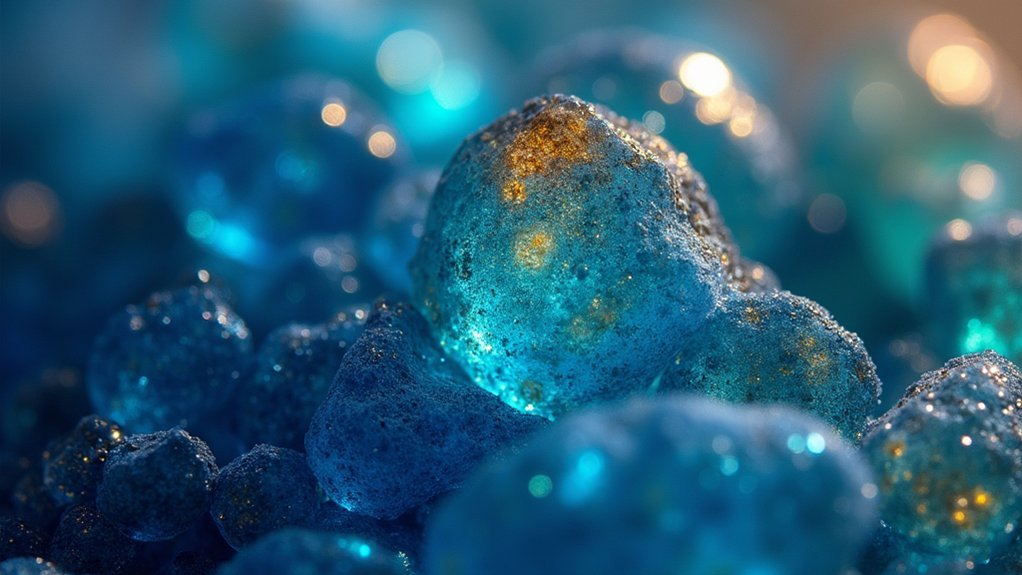
Although titanium diffusion creates stunning blue sapphires that command attention in the marketplace, detecting this treatment requires sophisticated analytical methods that go far beyond simple visual inspection.
Titanium diffusion produces captivating blue sapphires, but identifying this treatment demands advanced laboratory analysis beyond basic visual examination.
You’ll need advanced laboratory techniques to distinguish titanium diffusion from standard heat treatment, as both processes can enhance color saturation dramatically.
Professional gemologists rely on these cutting-edge detection methods:
- Secondary ion mass spectrometry (SIMS) for precise chemical analysis
- Laser ablation inductively coupled plasma mass spectrometry (LA-ICP-MS) for elemental mapping
- Visual examination of characteristic color zoning patterns
- Assessment of angular zoning and feather inclusions
You should be aware that diffusion-treated stones may exhibit unstable color properties, potentially fading under specific lighting conditions or heat exposure, unlike their heat-treated counterparts.
Laboratory Testing Vs Visual Assessment
While sophisticated laboratory methods like SIMS and LA-ICP-MS deliver definitive identification of sapphire treatment, you’ll find that visual assessment techniques can serve as powerful preliminary screening tools that cost considerably less.
When you immerse stones in water under diffused white lighting, you can observe distinct color zoning patterns. Diffusion-treated sapphires typically show concentrated color in the center with angular zoning, while heat-treated stones display more uniform coloration.
A 2003 study demonstrated that visual assessment achieves 80% confidence levels in identifying treatment types. However, you shouldn’t rely solely on visual methods for final determinations.
Laboratory testing remains essential for thorough analysis, so you should send questionable stones to reputable labs when treatment history affects valuation or certification requirements.
Price Differences Between Treatment Types
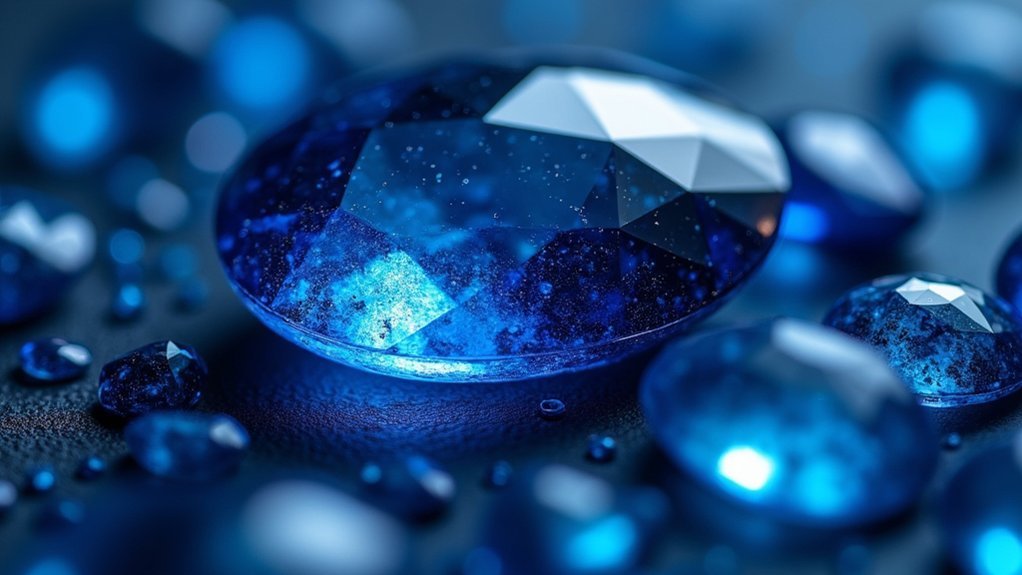
The treatment type you’re considering dramatically affects a sapphire’s market price, with differences reaching 100-fold between categories.
Understanding these price differences between treatment types is vital when purchasing sapphires, as treatments that enhance their color impact value considerably.
Here’s how treatment types affect pricing:
- Heat-treated sapphires – $1,500 per carat (industry standard)
- Diffusion-treated sapphires – $15 per carat (dramatically lower value)
- Untreated sapphires – Premium pricing above heat-treated stones
- Market prevalence – 95% of sapphires undergo heat treatment
The stark contrast exists because diffusion treatments can completely alter or intensify colors artificially, while heat treatment simply improves existing characteristics.
When evaluating treated ones, remember that rarer untreated sapphires command higher prices than their processed counterparts, making treatment identification vital for informed purchasing decisions.
Equipment Needed for Preliminary Testing
Before investing in expensive laboratory analysis, you’ll need basic gemological equipment to conduct preliminary testing that can identify diffusion treatments with approximately 80% confidence.
Basic gemological tools can reliably identify diffusion treatments in sapphires with 80% accuracy before requiring costly laboratory analysis.
A standard gemological microscope is essential for examining inclusions and color zoning patterns that reveal high temperature heating treatments. You’ll want a refractometer to measure refractive index values, helping distinguish between natural and treated stones.
For immersion testing, methanol iodide provides ideal results, though water works as a practical alternative for observing color concentration. Use diffused white lighting during examination to reveal subtle color and clarity variations indicating treatment.
These techniques used together through visual observation and magnification provide reliable preliminary identification of diffusion treatments in heat-altered sapphires.
When Professional Gemological Analysis Is Required
Preliminary testing methods hit their limits when you’re dealing with borderline cases or high-value stones where accuracy determines thousands of dollars in valuation differences.
Professional gemological analysis becomes essential when visual observations can’t definitively distinguish between normal heat-treated sapphires and diffusion-treated specimens.
You’ll need advanced laboratory testing when encountering these situations:
- Inconclusive visual evidence of treatment types
- Stones valued above $500 where misidentification risks significant financial loss
- Insurance appraisals requiring documented authenticity
- Commercial transactions demanding certification
Reputable gemological laboratories use sophisticated equipment like SIMS and LA-ICP-MS to provide conclusive evidence.
While these tests cost more upfront, they’re vital when the price difference between normal heat-treated sapphires ($1,500/carat) and diffusion-treated stones ($15/carat) makes accuracy financially critical.
Frequently Asked Questions
What Is a Diffusion Treatment for Sapphires?
You’ll find diffusion treatment involves exposing sapphires to extreme heat while introducing color-inducing elements like titanium or beryllium. This process artificially creates vibrant colors that weren’t originally present in the stone.
What Is the Heat Treatment for Sapphires?
You’ll find heat treatment involves heating sapphires to 1700°C to improve color and clarity by dissolving silk inclusions. It’s considered natural enhancement since there’s no added substances, just controlled heat application.
Are Diffused Sapphires Worth Anything?
You’ll find diffused sapphires have minimal value at roughly $15 per carat compared to $1,500 for heat-treated stones. They’re considerably less desirable due to treatment history affecting rarity and investment potential.
Are Heat-Treated Sapphires Worth Anything?
You’ll find heat-treated sapphires are definitely worth something, typically around $1,500 per carat. They’re less valuable than untreated stones but still constitute 95% of today’s sapphire market.
In Summary
You’ll need to combine visual inspection with proper testing equipment to accurately identify diffusion treatments in heat-altered sapphires. While you can spot obvious color concentration patterns and surface heating evidence yourself, don’t rely solely on visual assessment. Use immersion testing and magnification tools for preliminary detection, but remember that professional gemological analysis remains essential for definitive identification. Understanding these differences will help you make informed purchasing decisions and avoid overpaying for diffusion-treated stones.

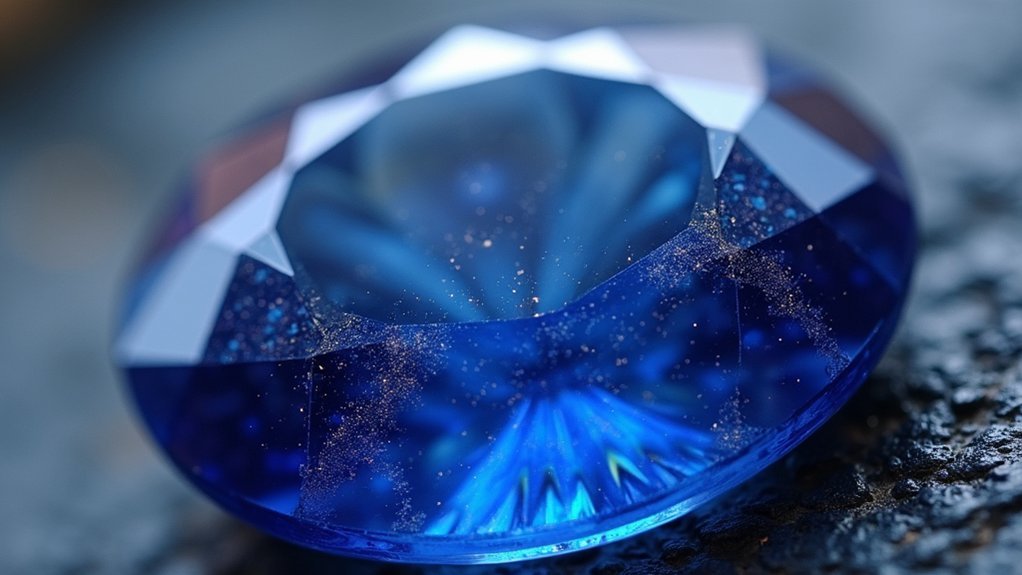
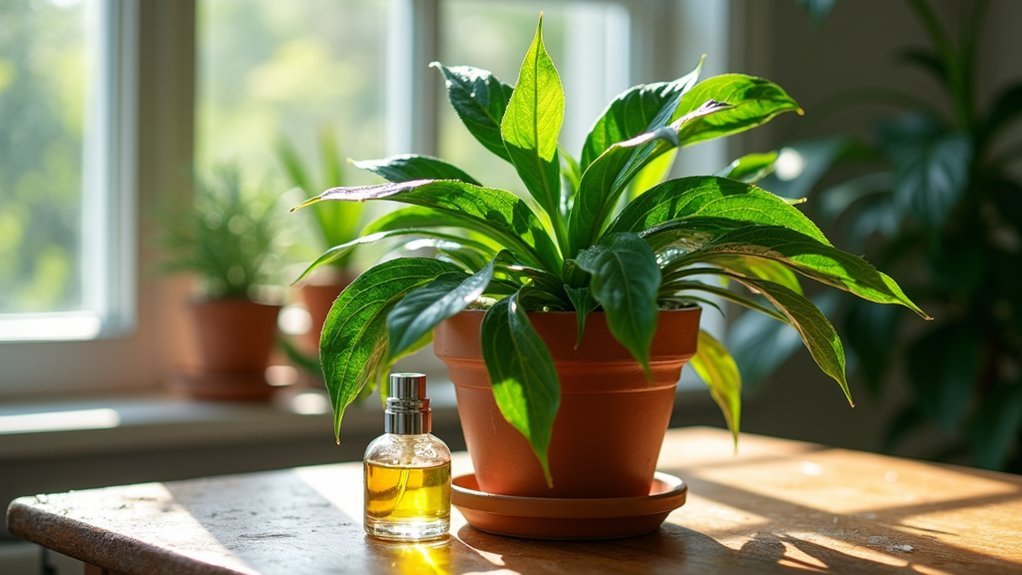
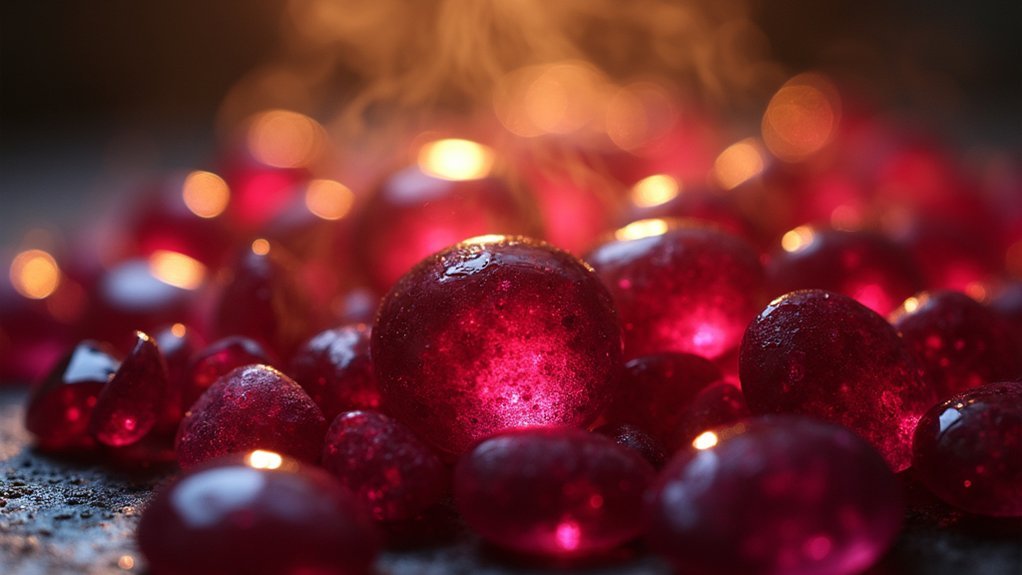
Leave a Reply